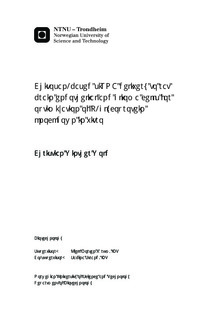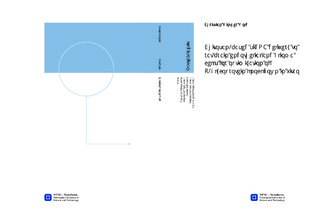| dc.description.abstract | The purpose of this thesis was to investigate the transfection efficiencies of chitosan- siRNA nanoparticles in the two rat brain-derived cell lines C6 and RBE4. Furthermore, the main goal was to silence P-glycoprotein (P-gp) expression in these cell lines and to assess the possibility of implementing them in a future glioma-blood- brain barrier (BBB) model in vitro. Finally, previously developed serum-stable chitosans were screened for transfection efficiencies in the RBE4 cell line to evaluate their potential in in vivo applications.Linear (LIN350) and self-branched (SB300) chitosans were tested for their transfection efficiencies in the C6 glioma cell line. Uptake of the nanoparticles was measured using fluorescent siRNA by flow cytometry. Knockdown of GAPDH was measured using a GAPDH protein activity assay, and P-gp knockdown was measured by flow cytometry using a Rhodamine123 (R123) efflux assay.The uptake efficiency was optimal at N/P ratio 30 and with a siRNA concentration of 100 nM. SB300 was more cytotoxic than LIN350, as indicated by the decrease in GAPDH protein activity when using negative control siRNA. It was found by reverse transcriptase PCR (RT-PCR) that the C6 cells did not initially express the Abcb1a gene, but expression was initiated after several passages in cell culture. The results show that the C6 cell line has the potential to be implemented in a future glioma-BBB model, however there is a need for optimization of the transfection when using chitosan-siRNA nanoparticles for P-gp silencing in this cell line.Rat Brain Endothelial (RBE4) cells were used as an in vitro BBB-model, and several chitosans were investigated in regards to transfection efficiencies in this cell line. LIN350 and SB300 mediated efficient transfection at N/P 30 and a siRNA concentration of 100 nM. An uptake kinetics experiment was also carried out showing that the siRNA is removed within two days from RBE4 cells when using these chitosans. From a P-gp knockdown kinetics experiment measuring R123 efflux, it was found that repeated transfection with LIN350-based nanoparticles prolonged the knockdown of P-gp. LIN350 was used for transfecting confluent RBE4 cells; mediating knockdown efficiencies of GAPDH comparable to non-confluent cells. This indicates that RBE4 cells could be used as endothelial cells in a future glioma- BBB model.In addition to LIN350 and SB300, several modified chitosans with increased serum stability ((DP85 (4AM), Fa=0 (2% PEG) and chitosans coated with hyaluronic acid (HA)), developed for efficient in vivo siRNA delivery were screened for their in vitro transfection efficiencies, measuring uptake, GAPDH protein activity and R123 efflux. The serum-stable chitosans mediated high uptake but did not produce RNA interference (RNAi), indicating that these chitosans need further modifications before they can be utilized for in vivo experiments.It was found by transmission electron microscopy (TEM) that nanoparticles with LIN350, LIN350 w/HA, DP85 (4AM) and Fa=0 (2% PEG) were internalized by the RBE4 cells in vesicles larger than 500 nm, indicating that macropinocytosis is a highly possible uptake mechanism utilized by these chitosans. LIN350 was the only chitosan among these formulations that mediated RNAi, and the TEM showed that this chitosan is taken up in large aggregates, possibly bursting the vesicles by osmotic swelling. | nb_NO |

